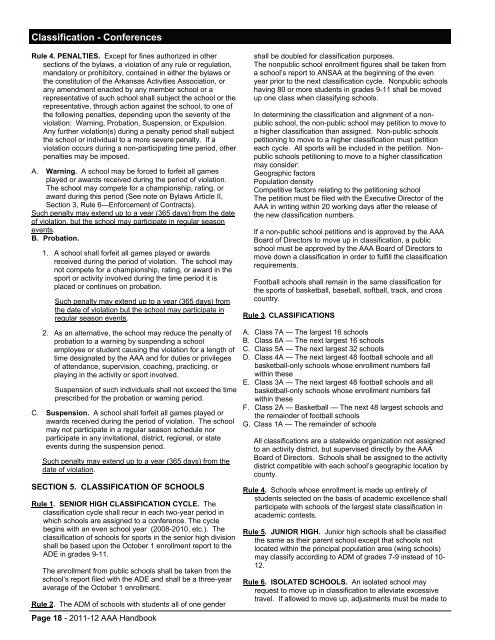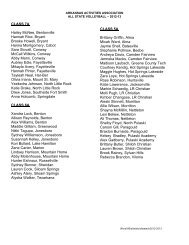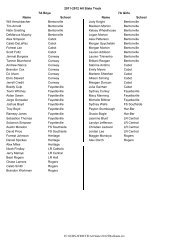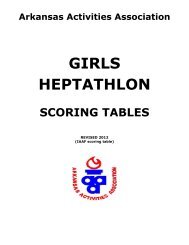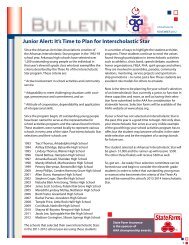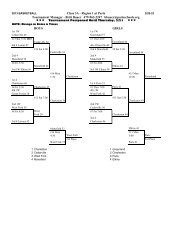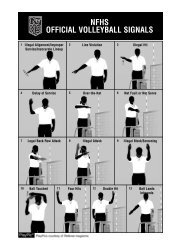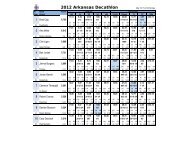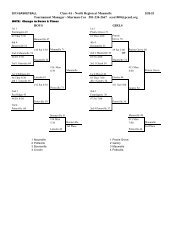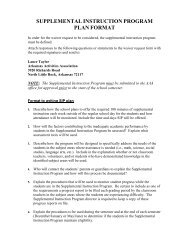2011-2012 AAA Handbook - Arkansas Activities Association
2011-2012 AAA Handbook - Arkansas Activities Association
2011-2012 AAA Handbook - Arkansas Activities Association
You also want an ePaper? Increase the reach of your titles
YUMPU automatically turns print PDFs into web optimized ePapers that Google loves.
Classification - Conferences<br />
Rule 4. PENALTIES. Except for fines authorized in other<br />
sections of the bylaws, a violation of any rule or regulation,<br />
mandatory or prohibitory, contained in either the bylaws or<br />
the constitution of the <strong>Arkansas</strong> <strong>Activities</strong> <strong>Association</strong>, or<br />
any amendment enacted by any member school or a<br />
representative of such school shall subject the school or the<br />
representative, through action against the school, to one of<br />
the following penalties, depending upon the severity of the<br />
violation: Warning, Probation, Suspension, or Expulsion.<br />
Any further violation(s) during a penalty period shall subject<br />
the school or individual to a more severe penalty. If a<br />
violation occurs during a non-participating time period, other<br />
penalties may be imposed.<br />
A. Warning. A school may be forced to forfeit all games<br />
played or awards received during the period of violation.<br />
The school may compete for a championship, rating, or<br />
award during this period (See note on Bylaws Article II,<br />
Section 3, Rule 6—Enforcement of Contracts).<br />
Such penalty may extend up to a year (365 days) from the date<br />
of violation, but the school may participate in regular season<br />
events.<br />
B. Probation.<br />
1. A school shall forfeit all games played or awards<br />
received during the period of violation. The school may<br />
not compete for a championship, rating, or award in the<br />
sport or activity involved during the time period it is<br />
placed or continues on probation.<br />
Such penalty may extend up to a year (365 days) from<br />
the date of violation but the school may participate in<br />
regular season events.<br />
2. As an alternative, the school may reduce the penalty of<br />
probation to a warning by suspending a school<br />
employee or student causing the violation for a length of<br />
time designated by the <strong>AAA</strong> and for duties or privileges<br />
of attendance, supervision, coaching, practicing, or<br />
playing in the activity or sport involved.<br />
Suspension of such individuals shall not exceed the time<br />
prescribed for the probation or warning period.<br />
C. Suspension. A school shall forfeit all games played or<br />
awards received during the period of violation. The school<br />
may not participate in a regular season schedule nor<br />
participate in any invitational, district, regional, or state<br />
events during the suspension period.<br />
Such penalty may extend up to a year (365 days) from the<br />
date of violation.<br />
SECTION 5. CLASSIFICATION OF SCHOOLS<br />
Rule 1. SENIOR HIGH CLASSIFICATION CYCLE. The<br />
classification cycle shall recur in each two-year period in<br />
which schools are assigned to a conference. The cycle<br />
begins with an even school year (2008-2010, etc.). The<br />
classification of schools for sports in the senior high division<br />
shall be based upon the October 1 enrollment report to the<br />
ADE in grades 9-11.<br />
The enrollment from public schools shall be taken from the<br />
school’s report filed with the ADE and shall be a three-year<br />
average of the October 1 enrollment.<br />
Rule 2. The ADM of schools with students all of one gender<br />
Page 18 - <strong>2011</strong>-12 <strong>AAA</strong> <strong>Handbook</strong><br />
shall be doubled for classification purposes.<br />
The nonpublic school enrollment figures shall be taken from<br />
a school’s report to ANSAA at the beginning of the even<br />
year prior to the next classification cycle. Nonpublic schools<br />
having 80 or more students in grades 9-11 shall be moved<br />
up one class when classifying schools.<br />
In determining the classification and alignment of a nonpublic<br />
school, the non-public school may petition to move to<br />
a higher classification than assigned. Non-public schools<br />
petitioning to move to a higher classification must petition<br />
each cycle. All sports will be included in the petition. Nonpublic<br />
schools petitioning to move to a higher classification<br />
may consider:<br />
Geographic factors<br />
Population density<br />
Competitive factors relating to the petitioning school<br />
The petition must be filed with the Executive Director of the<br />
<strong>AAA</strong> in writing within 20 working days after the release of<br />
the new classification numbers.<br />
If a non-public school petitions and is approved by the <strong>AAA</strong><br />
Board of Directors to move up in classification, a public<br />
school must be approved by the <strong>AAA</strong> Board of Directors to<br />
move down a classification in order to fulfill the classification<br />
requirements.<br />
Football schools shall remain in the same classification for<br />
the sports of basketball, baseball, softball, track, and cross<br />
country.<br />
Rule 3. CLASSIFICATIONS<br />
A. Class 7A — The largest 16 schools<br />
B. Class 6A — The next largest 16 schools<br />
C. Class 5A — The next largest 32 schools<br />
D. Class 4A — The next largest 48 football schools and all<br />
basketball-only schools whose enrollment numbers fall<br />
within these<br />
E. Class 3A — The next largest 48 football schools and all<br />
basketball-only schools whose enrollment numbers fall<br />
within these<br />
F. Class 2A — Basketball — The next 48 largest schools and<br />
the remainder of football schools<br />
G. Class 1A — The remainder of schools<br />
All classifications are a statewide organization not assigned<br />
to an activity district, but supervised directly by the <strong>AAA</strong><br />
Board of Directors. Schools shall be assigned to the activity<br />
district compatible with each school’s geographic location by<br />
county.<br />
Rule 4. Schools whose enrollment is made up entirely of<br />
students selected on the basis of academic excellence shall<br />
participate with schools of the largest state classification in<br />
academic contests.<br />
Rule 5. JUNIOR HIGH. Junior high schools shall be classified<br />
the same as their parent school except that schools not<br />
located within the principal population area (wing schools)<br />
may classify according to ADM of grades 7-9 instead of 10-<br />
12.<br />
Rule 6. ISOLATED SCHOOLS. An isolated school may<br />
request to move up in classification to alleviate excessive<br />
travel. If allowed to move up, adjustments must be made to


